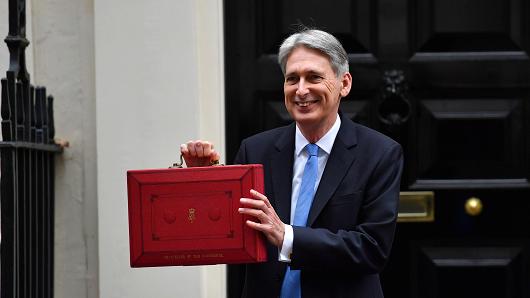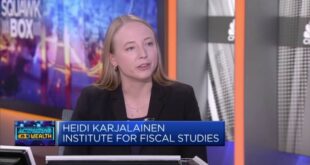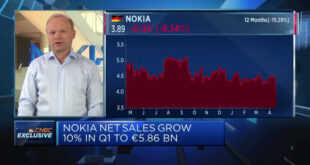
BEN STANSALL | AFP | Getty Images
British Chancellor of the Exchequer Philip Hammond poses for pictures with the Budget Box as he leaves 11 Downing Street in London, on November 22, 2017, before presenting the government’s annual Autumn budget to Parliament.
Britain’s sluggish economy will grow slightly more quickly than previously thought this year in the run-up to Brexit, lowering the government’s expected borrowing, finance minister Philip Hammond said on Tuesday.
Hammond, delivering a half-yearly update on the public finances, said Britain’s budget forecasters expect the economy to grow by 1.5 percent in 2018, up a touch from a forecast of 1.4 percent in November.
Growth forecasts in 2019 and 2020 were kept unchanged at 1.3 percent, Hammond told parliament, citing figures from the independent Office for Budget Responsibility.
The world’s sixth-biggest economy would grow a bit more slowly than previously thought in the following two years, by 1.4 and 1.5 percent respectively in 2021 and 2022.
Britain’s economy has slowed sharply since the vote in June 2016 to leave the European Union.
Earlier on Tuesday, the Organisation for Economic Cooperation and Development said Britain would grow more slowly than all the other Group of 20 leading economies this year.
However, a strong global recovery has helped to cushion the slowdown in Britain in recent months.
The improved outlook for growth means the government will borrow less by the early years of the next decade than previously forecast, Hammond said.
The budget deficit for the current 2017/18 fiscal year has been cut to an estimated 45.2 billion pounds from a forecast of 49.9 billion pounds made in November, Hammond said.
The shortfall was also cut for the following years, although the government is still seen running a small deficit by 2022/23, the end of the OBR’s forecast period.
Britain has cut its annual borrowing from 10 percent of gross domestic product in 2010, when it was reeling from the global financial crisis, to just over 2 percent now.
Some lawmakers in Hammond’s Conservative Party have urged him to take advantage of the progress in reducing the deficit to spend more on an over-stretched health system, the military and other services.
They want to check a rise in support for the opposition Labour Party which has promised to end the Conservative squeeze on public-sector pay and invest more in infrastructure.
Hammond has said he might be able to allow a bit more public spending later this year.
 EU News Digest Latest News & Updates
EU News Digest Latest News & Updates


